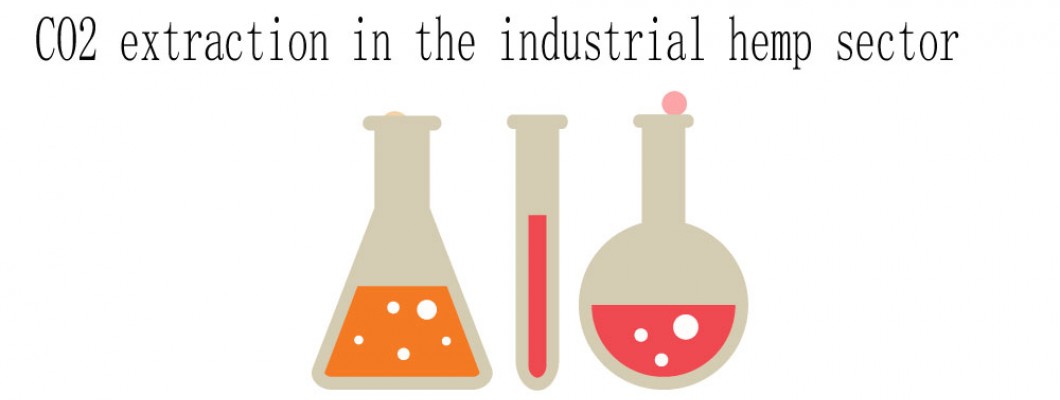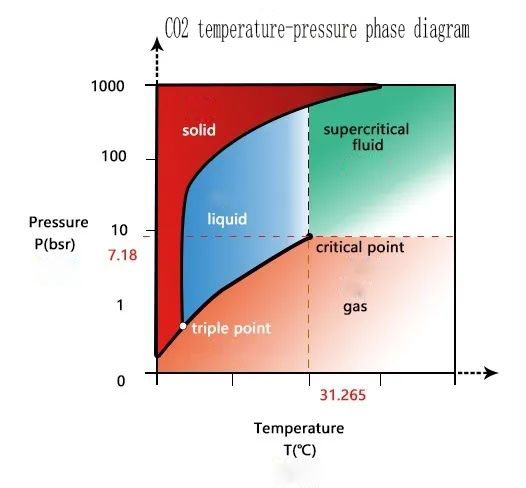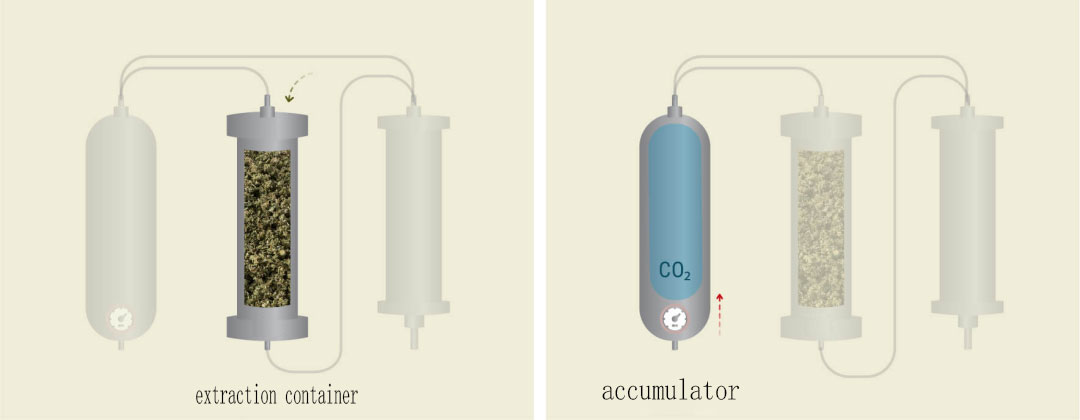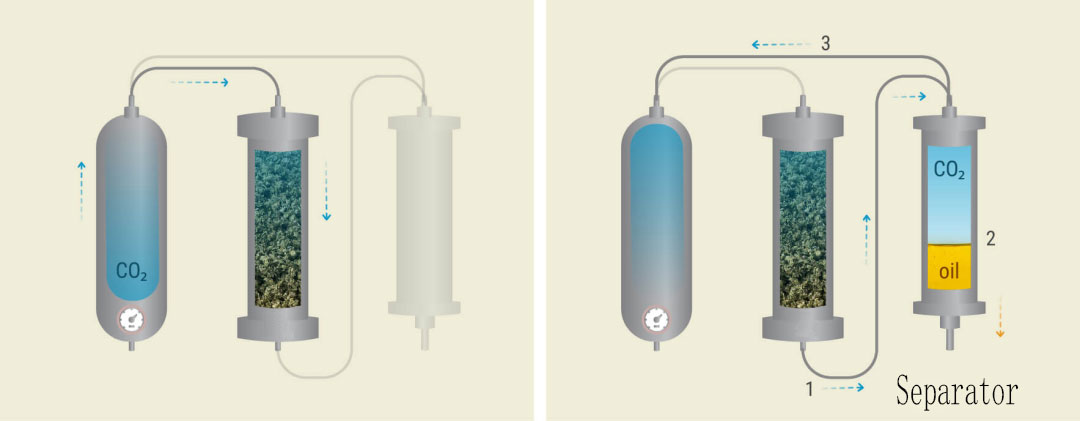
Carbon dioxide extraction has taken over half of the industrial hemp and CBD industry. This newer technology is more environmentally friendly, non-toxic and non-flammable. In it, supercritical CO₂ is used both as a liquid and as a gas to efficiently extract as much terpene and cannabinoid as possible.
CO₂ extraction has swept through the industrial hemp industry. By controlling the temperature and pressure levels, CO₂ extraction is used to extract terpenes, cannabinoids and other components from the industrial hemp plant, minimising impurities and reducing oxidation. As a result, the original smell and essence of the extracted industrial hemp variety is maintained. Unlike older extraction methods, CO₂ extraction not only eliminates the risk of residual solvents in the final product, but also results in a higher quality extract.
Using this technology, manufacturers are making higher purity, higher concentration CBD oils, terpene blends and full spectrum extracts than ever before. Join us as we look at the reasons why extract manufacturers are choosing supercritical CO₂, how to use CO₂ to make CBD oil and the process.
What is supercritical CO₂ extraction?
 The term "supercritical carbon dioxide extraction" may at first glance seem complicated and may bring to mind images of scientists buried in laboratories performing complex scientific research processes over and over again. But it is actually quite easy to understand: CO₂ is available in solid, liquid or gaseous form: at a very low temperature of -78.5°C at 1 atmosphere, CO₂ exists as a solid called dry ice; at temperatures above -78.5°C, CO₂ turns into a gas; and at temperatures around -40°C at 100 atmospheres, it exists as a liquid.
The term "supercritical carbon dioxide extraction" may at first glance seem complicated and may bring to mind images of scientists buried in laboratories performing complex scientific research processes over and over again. But it is actually quite easy to understand: CO₂ is available in solid, liquid or gaseous form: at a very low temperature of -78.5°C at 1 atmosphere, CO₂ exists as a solid called dry ice; at temperatures above -78.5°C, CO₂ turns into a gas; and at temperatures around -40°C at 100 atmospheres, it exists as a liquid.
So, what is supercritical carbon dioxide again? The term "supercritical" refers to another form of CO₂ that has the properties of both a liquid and a gas. By adjusting the pressure and temperature of the CO₂ extractor at a pressure of 100 atmospheres and a temperature of approximately 27°C, CO₂ can exceed its "critical point" and become supercritical CO₂. CO₂ in its supercritical state is a green organic solvent. It is non-flammable, non-toxic and inert, yet effective in extracting compounds such as cannabinoids, terpenes and other cannabis components.
How does CO₂ extraction work?
CO₂ extraction equipment is generally large and extremely expensive, comprising a range of vessels and pipework. It is bulky and consists of many parts, including the CO₂ tank, pump, extraction vessel, separator and collection vessel. Due to its size and cost, only companies with large investments are usually able to use this technology to make top quality industrial hemp extracts. Currently, most extractors are limited to using high-concentration alcohol extraction methods. But it could be that in a few years CO₂ extractors will be in millions of homes and everyone will be able to make the cleanest CBD oil ever. Just as the world's first computer weighed 30 tonnes a few decades ago, now everyone can carry a laptop around with them.
As a gas, supercritical CO₂ can pass through very small interstices within plant cells; and when it is a liquid, it can absorb beneficial plant components during the flow. CBD oil can be created by simply loading an extractor with industrial hemp flowers with a high CBD content. As the supercritical carbon dioxide flows through the flower buds, it absorbs large amounts of CBD and terpenes from them, which are then injected into the carrier oil when the extraction is complete.
Supercritical and subcritical CO₂ extraction
So what is the difference between supercritical and subcritical extraction?

The subcritical CO₂ state occurs at a lower temperature, below the critical point ('sub' means 'below'), but at this point the CO₂ is still under great pressure and is therefore still in a liquid state. As a pure liquid, CO₂ can also be used as an effective solvent. However, because it has not yet become a gas, it does not move in the same way within the plant cell. Subcritical CO₂ is less effective as a solvent, which means that it does not absorb as many components as supercritical CO₂. However, there are some benefits to this extraction method.
Because subcritical CO₂ extraction uses lower temperatures, it retains some of the more volatile terpenes found in industrial hemp; for substances that begin to degrade at relatively mild temperatures, extraction with critical CO₂ is common practice. Essentially, subcritical CO₂ extraction can produce terpene-rich products that are not possible by other means.
Overall, supercritical CO₂ extraction has been favoured by the industrial hemp industry for its efficiency. While some terpenes may degrade, most will remain intact and this extraction method will extract more each time.
CO₂ extraction steps
Only trained technicians can operate the supercritical CO2 extractor. The extraction process is divided into four main stages.
Loaded with industrial hemp
In the first stage, technicians load industrial hemp into an extraction container (a large metal tube). In order to be able to fill as much industrial hemp as possible, it is usually processed in advance into finer particles. Finer particles also increase the surface area, which allows the solvent to collect more active substances.
CO₂ above the threshold
After filling the industrial hemp, the technician proceeds to change the settings of the extractor to release the liquid carbon dioxide into the accumulator of the machine. By increasing the temperature and pressure in this part of the extractor, the liquid carbon dioxide is placed in conditions that exceed the critical point and enter a supercritical state.

Supercritical CO₂ injection into industrial hemp
The supercritical carbon dioxide then leaves the accumulator and enters the extraction vessel - the tube containing the processed industrial hemp.
Due to the nature of the gas, the carbon dioxide squeezes through the tiniest gaps between the plant matter. And by virtue of the properties of the liquid solvent, it absorbs valuable molecules such as THC and CBD, as well as terpenes such as alpha-pinene and lauricene.
Phase exchange
After passing through the extraction vessel and absorbing the cannabinoids and terpenes, the supercritical carbon dioxide enters the separator through a tube at the bottom of the vessel. Changes in temperature and pressure cause the cannabinoids to separate from the carbon dioxide and form an oil. The less dense carbon dioxide passes through the top of the separator and becomes liquid again, ready for another run in the future. A further feature of this closed-loop system is that the carbon dioxide is recovered after extraction without waste.
The composition of the final product depends to a large extent on the industrial hemp raw material used: using flowers with a high THC content produces a THC extract with psychoactive effects, while flowers with a high CBD content produce a CBD extract without psychoactive effects.

More applications for supercritical CO₂ extraction
Supercritical CO₂ extraction first appeared in the 1980s and since then has optimised extraction processes for many different products in the food and beverage industry. The characteristics of supercritical CO₂ extraction dictate a very wide range of applications. Although new to the industrial hemp industry, other industries have been adopting this efficient, green and safe extraction method for decades.
Coffee companies have been using this technology for a long time to remove caffeine from their products to produce caffeine-free coffee. Carbon dioxide extractors can also be used to remove trichloroanisole from corks - a compound that adds an unpleasant flavour to wine - and once removed, billions of unflavoured corks can be produced. Carbon dioxide extraction can also extract antioxidants (such as anthocyanins) from blueberries and other fruits.
Many retailers now label their products as "CO₂ extracted products" to demonstrate their commitment to purity and a more environmentally friendly manufacturing process.
What are the benefits of using CO₂?
Supercritical CO₂ extraction offers a number of advantages. It is these advantages that have led many industrial hemp companies to move away from old extraction methods and invest in this technology.
Nature: Above all, manufacturers and consumers alike see carbon dioxide as a more natural option. Carbon exists everywhere in nature and our bodies produce it every minute of every day.
FDA approval: Confidence in supercritical CO2 extraction has been boosted by its approval as a safe solvent by the US Food and Drug Administration (FDA) and the European Food Safety Authority (EFSA).
Non-toxic: Supercritical CO2 extraction has taken the world by storm in part because of its non-toxic nature - unlike solvents such as butane, CO2 is safe for human health and the environment.
Clean: The supercritical CO2 extractor is designed to recover all the liquid CO2 present in the machine after extraction. This means that the extract from the other end is free from solvent residues and is very pure.
Non-flammable: you may have heard stories of people blowing their roofs off while using butane for industrial hemp extraction. This is due to the flammability of butane, whereas carbon dioxide is not combustible and does not usually support combustion.
What products can be produced by CO₂ extraction?
Manufacturers can use this extraction technology to make large quantities of industrial hemp products. The shelves of foreign dispensaries are already filled with a variety of CO2-extracted products, including:
- CBD oil
- Tetrahydrocannabinol isolate
- CBD isolate
- Full spectrum extracts
As research continues, more and more cannabinoids and terpenes are being uncovered in the plant, and with increased awareness and improved technology, the application of CO2 extraction in the extraction and processing of industrial hemp will become more widespread, and more CO2-extracted industrial hemp products are expected to appear in the near future.

Leave a Comment